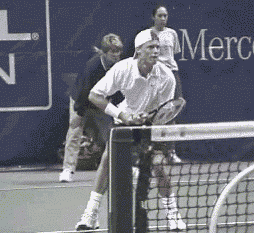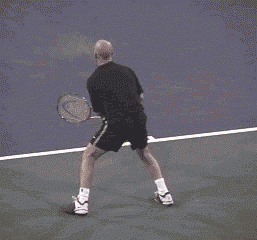<% ns_puts [mkm_getnavbar] %>
Balance and Vision:
Underlying Fundamentals?
by Jim McLennan
|
An overview of the current magazines, as well as some of the latest books on tennis technique appear to prioritize racquet swinging mechanics as the central aspect of the fundamentals. Issues include the grip, the stance, the path of the racquet, and the nature of the follow through.
My question, are there elements that precede or override these mechanical notions, are there fundamentals that are more basic than swing path and grip?
From a review of two fascinating resources, Batting Basics by John White, and Vision Dynamics by William Harrison, I am persuaded that before anything about the swing, the two central skill sets mastered by the professionals, and the two central skill sets we can all improve are:
-
Dynamic rotational balance
-
Visual skills.
Connors or Agassi turn into the ball on balance, on perfect balance. McEnroe or Hewitt track the ball like a hawk, their vision centered, focused, and keen. Can you and I improve in these areas, absolutely!
John White compares the baseball (and tennis) batting swing to the properties of a spinning top, and its (yours) gyroscopic properties. A spinning top will not wobble when its axis of rotation is perfectly vertical, and when its axis (or your spine) tilts even a little the rotation becomes slower and the top starts to wobble. If your head and eyes are on top of this spinning top, this wobble will disrupt your vision. More on this later in the visual skills section.
White advises a wide stance, balance where both legs are equally weighted during the acceleration of the bat (racquet). The swing is compact so the moment of inertia is reduced, and the swing is driven essentially by a "dual" leg drive where the hips are the engine. All the open stance players use this method. Especially Safin, whose posture is impeccable, and somehow his turn is powerful but equally subtle, this also sounds like Barry Bonds.
In a practical on court example, when you turn to prepare is your posture unchanged or are you leaning over? When you begin to swing again is your posture erect or are you off balance? As you finish, are you on balance or again have you tilted? In all cases a well balanced turn allows greatest ease of motion, greatest racquet head speed with least effort, and somehow a fluid swing. Anything less in the way of balance, and you will be off.
|
Imagine McEnroe's posture, Hewitt's balance on the follow through, Agassi's posture and poise on his preparatory turn. Tracking the ball.
Interestingly, in the 1970's the Vision Dynamics training system, endorsed by batting average champion George Brett, was done in concert with Tom Stow. Stow cared everything about posture, about the tilt of the head, about the way the eyes turned to follow the ball with the ball also centered perfectly in the field of vision. Stow and Harrison both knew that depth perception is influenced by the line between the eyes, this stereoscopic perception is diminished when the eyes are not perfectly level. Further, when off balance, it is a reflex for the eyes to move to objects that are either horizontal or vertical to allow one to regain balance. So when off balance, at any moment during the swing, it will always be harder to follow the ball.
Harrison has specific eye training exercises to enhance your ability to focus, to track the ball, to pre visualize what you are expecting to see. Further, on recent Frontiers of Scientific American, a feature on the Quiet Eye, revealed secrets that professionals know about how to use the eyes that amateurs have yet to discover. Namely, a focus on technique as you strike the ball will diminish the quality of your eyesight. That primary visual focus on the target, whether it be free throw shooting, or concentration on the golf ball while putting, more often associates with success than when the player moves their eyes elsewhere or when the player is distracted from the 'quiet eye' by overly concentrating on technique.
So the next time you visit your tennis pro, or you watch a professional match, reevaluate your grasp of balance and visual skills - for these are the fundamentals, and no progress can be made on swing mechanics without these two already in place
Your comments are welcome. Let us know what you think about Jim McLennan's article by emailing us here at TennisONE.
|
Click here to order. |
The Secrets of World Class Footwork - Featuring Stefan Edberg
Pattern movements to the volleys, groundstrokes, and split step reactions. Rehearse explosive starts, gliding movements, and build your aerobic endurance. If you are serious about improving your tennis, footwork is the key.
29.95 |
Last Updated 8/1/02. To contact us, please email to: webmaster@tennisone.com
TennisONE is a registered trademark of TennisONE and SportsWeb ONE; Copyright 1995. All rights reserved.



